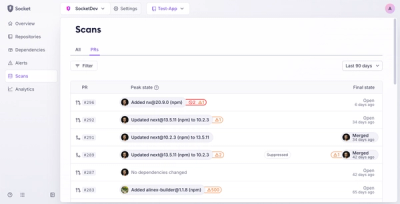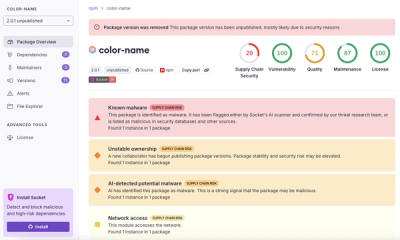
Security News
MCP Steering Committee Launches Official MCP Registry in Preview
The MCP Steering Committee has launched the official MCP Registry in preview, a central hub for discovering and publishing MCP servers.
eslint-config-amaze
Advanced tools
Deque's standardized ESLint configuration for Node and JavaScript applications.
JavaScript, being a dynamic and loosely-typed language, is especially prone to developer error. Without the benefit of a compilation process, JavaScript code is typically executed in order to find syntax or other errors. Linting tools like ESLint allow developers to discover problems with their JavaScript code without executing it.
As stated earlier, linting allows developers to produce and commit clean, valid, and consistent code. By sharing our ruleset we can ensure our developers are coding to Deque’s best practices and formatting standards. Our standard rulesets (there are two of them) can be found on our private Bitbucket:
Each is suited for its respective environments. What works in React may not work in Node, as an example.
If your project is under source control (such as Git) it may already include a copy of this ruleset. If not, require this file in your app with:
npm install --save-dev eslint-config-amaze
Once you have the ruleset locally or installed as a dependency, you’ll need the ESLinter. Depending on which editor you use determines how you install it.
If you use Sublime do the following:
installeslintAlternatively, if you use Atom, do the following:
eslint and select the linter-eslint packageBoth of these plugins will check first in the project directory, but if no ESLint configuration file is found it will traverse into more global locations, starting with its install directory (if a dependency). This means that you could optionally save our standardized ESLint configuration ruleset somewhere globally and then point your plugins to its location. This would work for all of your projects without having to have it installed locally. However, any local rulesets will override any global rulesets, unless your editor allows either/or.
If you’re using Node (i.e., have a package.json) file you may need to install a few additional packages:
eslint-config-standardeslint-plugin-standardeslint-plugin-promiseeslint-plugin-nodeeslint-plugin-importThese should be included with this package.
Once you get the dependencies installed, if you're using this package by itself, you'll need to add the following file to the root of your repository:
{
"extends": "eslint-config-amaze"
}
The filename needs to be .eslintrc.json.
FAQs
Deque's standardized ESLint configuration for Node and JavaScript applications.
We found that eslint-config-amaze demonstrated a not healthy version release cadence and project activity because the last version was released a year ago. It has 1 open source maintainer collaborating on the project.
Did you know?

Socket for GitHub automatically highlights issues in each pull request and monitors the health of all your open source dependencies. Discover the contents of your packages and block harmful activity before you install or update your dependencies.

Security News
The MCP Steering Committee has launched the official MCP Registry in preview, a central hub for discovering and publishing MCP servers.

Product
Socket’s new Pull Request Stories give security teams clear visibility into dependency risks and outcomes across scanned pull requests.

Research
/Security News
npm author Qix’s account was compromised, with malicious versions of popular packages like chalk-template, color-convert, and strip-ansi published.